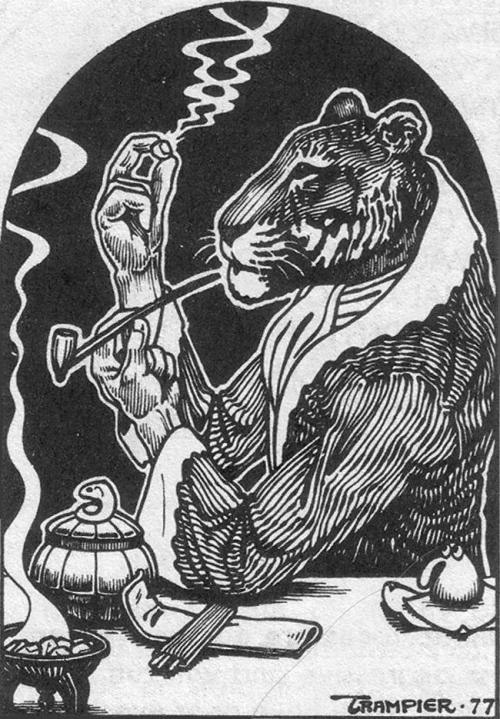 |
| So far, no anthropomorphic tigers in smoking jackets. Alas. |
I have been experimenting a bit with different ways of GMing and prepping this game, and that's made it a little weird too. I've been consciously trying to avoid being too intrusive / pushy as a GM, and encouraging players to take the narrative reins as much as they feel comfortable. Sometimes I feel like things would have gone a little more smoothly if I'd been more of a presence in the narrative, giving an extra nudge here and there to keep things clipping along, but I have mostly been satisfied to let the players more "space" to explore and see where they find themselves. The last few episodes I've been trying to keep things happening in the present so that they have lots of stuff to react to, adding a little movie-like "motion" to the story after the first four episodes took place largely in one location in the present.
One of the things I'd been hoping to improve on was to give scenes a bit more drive. We had a "half time report" meeting at the pub a few weeks ago, and checked in with each other to see how things were going. Rob had suggested that maybe we could borrow a few tricks from DRAMASYSTEM to give the characters more focus in dramatic scenes against each other -- specifically by giving each of them a thing they want from each other -- and we took a few notes. That was a great idea, but it didn't pay immediate dividends at the table, and we still had a few flaccid scenes. I think part of that is that the players are starting to have a lot of papers in front of them with a lot of information to manage, and it's not always easy to find the right thing in the right moment. I have two character sheets for the players, one of which contains a kind of relationship map, and several of the players have scattered notes as well. It's just a lot of stuff.
Last Saturday, I felt like we had a strong session where a few scenes really cooked and it felt like the game started to find a second gear. If I can keep that up, I think we're in good shape. I did a couple of things differently this time out. Firstly, I started with a scripted teaser to introduce the episode and get a few bits of exposition on the table seamlessly. These tend to help a session a lot, because they give everybody a common frame of reference and focus attention in the early moments when people's attention is wandering a bit. I've been avoiding them because I've been trying to be less of an intrusive presence in the game, but they worked well here. (Whether I'll continue using them or not I haven't decided yet.)
Secondly, I had been wanting to use a bit of other DRAMASYSTEM technology and borrow the "petitioner" / "granter" mechanic from that game, so that players would have a more concrete way of pushing for something they wanted in a scene. I wrote a column way back in 2014 about how DS's best stuff was modular, and how I was wondering if you could use it in an integrated way with FATE. It turns out, you can. I wrote up index cards with each player character's Aspects on them, and handed them out to the players at the beginning. When they were in a dramatic scene with another character, I asked them to hand them to the other player in the scene so they could see what Aspects they might Compel in a dramatic conflict. If they wanted something, they just had to push a point across the table like a regular Compel. I had been wanting players to do this kind of thing throughout the game, because I'm the sort of GM who often forgets to do so as the game is unfolding. (And my one gripe with FATE is that, even in the modern incarnations of the game, there are a lot of Aspects to keep track of. A LOT.)
The cards worked. It gave the players a concrete frame of reference for dramatic conflicts, and something tangible they could do to make a "push" in a scene. Almost immediately, we had one of the best scenes of the series so far. I was very pleased with that. I'm wondering if this could potentially destabilize the Fate point economy, in much the same way that PRIMETIME ADVENTURES can lose its urgency when the players accumulate too many drama points, but for now it seems to be working fine.
The session was short - just under three hours - but it felt like things have started to pick up.
No comments:
Post a Comment